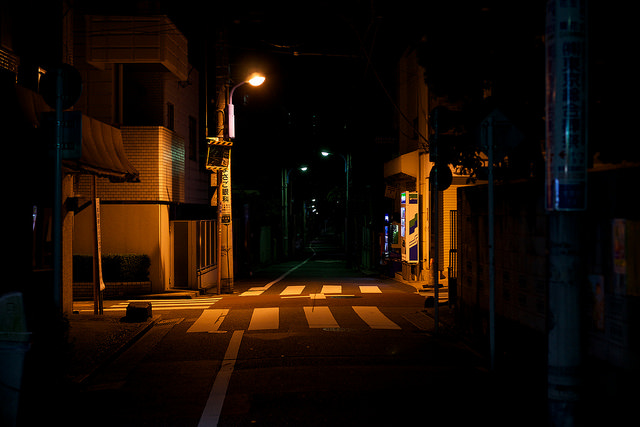Americans, and even the sociologists among us, tend to think about crime as a problem related to people and their economic characteristics. Crime, we theorize, is caused by poverty or relative poverty (larger differences between the haves and have nots), joblessness, more lucrative underground occupations, or an insufficient safety net.
Other scholars have examined non-economic correlates of crime. One study of serial killing, for example, found that these crimes were more common in big cities with higher percentages of single-person households. The anonymity of a bustling metropolis, plus the likelihood of finding people all alone in their apartment, may attract killers, tempt people who otherwise wouldn’t kill, or both. Reducing people’s isolation might be protective.
Another interesting non-economic factor that has gotten recent attention is lighting. When early lighting companies began lobbying cities to install the first street lights at the end of the 1800s, they argued that bright lights would certainly deter crime. Historian Ernest Freeberg, in his book The Age of Edison, writes that:
…lighting companies marketed their product as noting less than a police force on a pole. After nightfall, urban parks became notorious danger zones, a haven for the city’s dregs and an infernal playground of indecency. Now all that could end, not by converting sinners or reforming criminals, but by harnessing light’s power of exposure.
City leaders were swayed and artificial nighttime lighting in parks and streets eventually became an expected and routine part of city-building.

But does it work? The consensus appears to be maybe a little and no. The no comes from a new study, a natural experiment published in 2015. Since 2000, cities in England and Wales have reduced street lighting to save money and reduce carbon emissions. The study, led by social and environmental health researcher Rebecca Steinbach, found no clear correlation between turning the lights down and a rise in crime (or car crashes, for that matter).
I’m excited by this research on the relationship between crime and non-economic characteristics of cities, whether the hypotheses bear out or not. It gives us creative ideas about how we might reduce crime — above and beyond the all-important economic issues — and may also show us where we might be wasting our resources.
Lisa Wade, PhD is an Associate Professor at Tulane University. She is the author of American Hookup, a book about college sexual culture; a textbook about gender; and a forthcoming introductory text: Terrible Magnificent Sociology. You can follow her on Twitter and Instagram.
Comments 4
Corrina Holsman — November 19, 2020
Nice shit
Kimberly Hicks — July 24, 2021
A very thoughtful approach this is. As many crimes takes place in the dark only. If there is a bright light everywhere, the devil thoughts would eventually stay suppressed. I am also searching about crime scenes and how to maintain the safety. To complete my research work I have hired top wrter service to present my research. This important link can save your life as well. They are professional writers to serve you.
Suusy bonue — May 5, 2022
Each person decides his own destiny.
I'm an optimist. My motto in life is that it is better to try everything and make sure everything is vanity than to try nothing and live an empty life.
Liam Grayson — May 16, 2023
In most people's minds, there is a simple and direct relationship between lighting and crime: better lighting will deter offenders who benefit from the cover of darkness. As a writer of longest lasting headlight bulbs Improved lighting means that offenders are more likely to be seen by someone who might intervene, call the police, or recognize the offender.